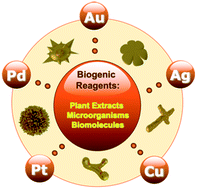Toward greener methods of producing branched metal nanostructures
Abstract
The continuous drive to develop green and sustainable production methods has prompted scientists into exploring the use of biogenic resources (e.g. plant extracts, microorganisms, and biomolecules) as environmentally benign reagents for the synthesis of functional metal nanomaterials. An emerging class of metal nanomaterials is branched metal nanostructures, which display tremendous potential in diverse technological areas, including biomedicine, catalysis, and sensing. In the biogenic synthesis of branched metal nanostructures, biological systems often take on multiple roles as reducing, capping, and shape-directing agents. Furthermore, the reaction typically proceeds at relatively lower temperatures, sometimes even at room temperature, and water is conveniently used as a solvent. This greatly simplifies the synthetic procedure, aside from lowering the production cost and rendering the process greener. Herein, we review different biogenic methods of preparing metal nanostructures having distinctively branched architectures (e.g. flowers, stars, and dendrites). We highlight reports that provide critical insights that are pertinent to the elucidation of the formation mechanisms. However, a more rigorous understanding is still necessary to establish exact mechanisms, and so, further research on this matter is encouraged. Advancing our mechanistic understanding will help us improve existing bioinspired methodologies to create high-quality branched metal nanostructures with optimal performance for envisioned applications.

- This article is part of the themed collection: 2020 Highlight article collection


 Please wait while we load your content...
Please wait while we load your content...